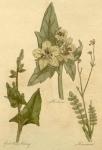A common plant in corn-fields and dry places, with extremely beautiful leaves from the root, and little umbels of white flowers. It has its English name from its virtues. Painful swellings are in some parts of the kingdom called hones, and the herb, from its singular effect in curing them, has received the name of honewort, that is, hone herb.
The root is long and white; there rise from it, early in the spring, half a dozen or more leaves, which lie spread upon the ground, in an elegant manner, and are all that is generally observed of the plant. The stalks do not rise till the end of summer, and these leaves decay by that time, so that they are not known to belong to it. These leaves are eight inches long, and an inch and a half in breadth: they are composed each of a double row of smaller leaves, set on a common rib, with an odd leaf at the end; these are oblong, tolerably broad, and indented in a beautiful manner. They are of a fresh green colour; they are the part of the plant most seen, and the part to be used; and they are not easily confounded with those of any other plant, for there is scarce any that has what are nearly so handsome. The stalk is two feet high, round, hollow, upright, but not very firm, and branched toward the top. The leaves on it are somewhat like those from the root, but they have not the singularity of those beautiful and numerous small ones; the flowers are little and white, and the seeds are small, flatted, striated, and two of them follow every flower.
The leaves are to be used; they are to be fresh gathered and beat in a marble mortar into a kind of paste. They are to be laid on a swelling that is red, painful, and threatens to have bad consequences, and they disperse it. The application must be frequently renewed, and there are those who speak of its curing the evil.


